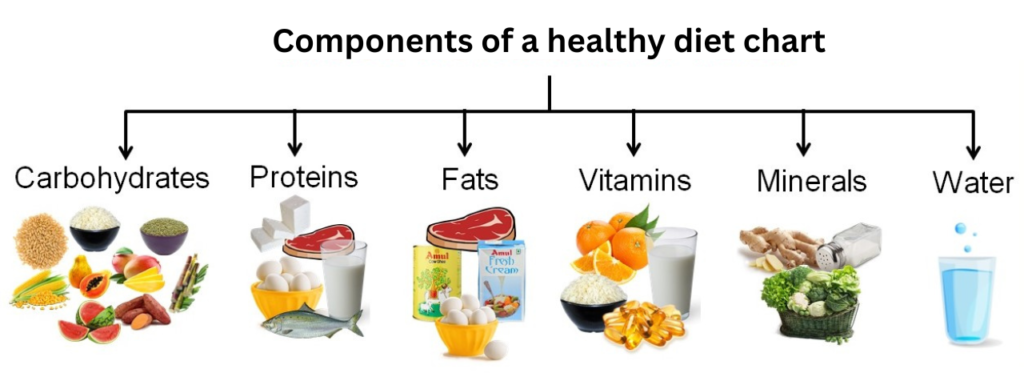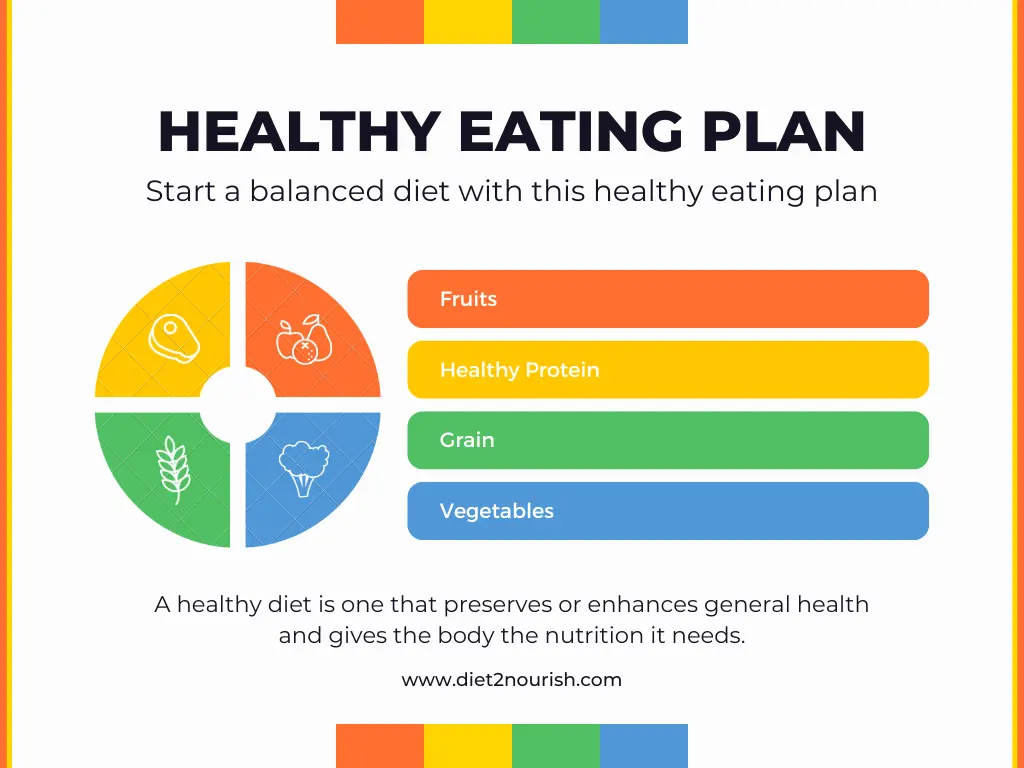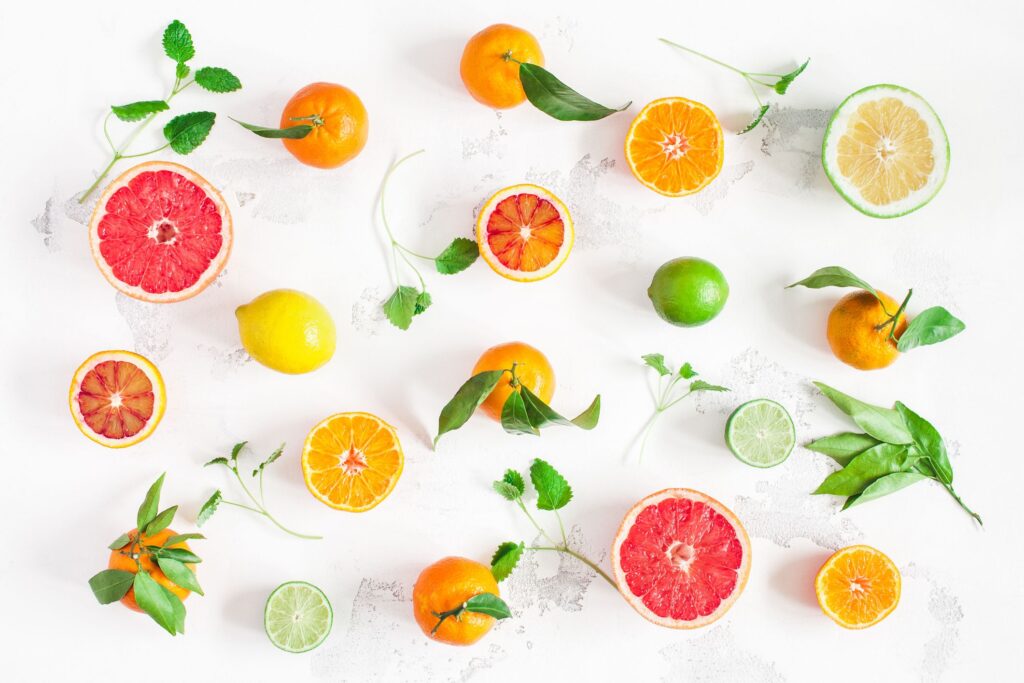Balanced Diet Chart
Get your very own balanced diet chart for a new journey. This diet will help you lose bad fat and get muscle mass. It is all that you ever needed to get a slim body. So, make way for a healthier you with us.
Here, you can find all the guidelines. This is a journey on how to get fit with good food. You can find all the secrets that will help you get and stay fit. This is the first step towards your fitness. So, grab this chance now!
Health benefits of a balanced diet chart
A healthy diet chart has a number of health perks:
● Gives you nutrients:
Such a diet has a proper ratio of all vitals. The most crucial one is protein. For energy, it can give you a lot of good carbs. It has good fats. They are vital for your health.
● Boosts energy levels:
A well balanced diet will fuel your body while you burn calories. It can give energy to your body. With this, you can stay active and perform daily tasks.
● Leads to a healthy weight:
A good diet will help you have a healthy weight. The foods in it are as per your body type. It prevents unhealthy weight gain or loss.
● Good for heart health:
A balanced diet says no to saturated and trans fats. They are known as bad fats. By eating such a diet, you can be free from heart illnesses. Thus, giving you a healthy heart.
● Good for brain:
A balanced diet chart has foods rich in nutrients. It can help your brain function well. You can get rid of memory loss. Thus, it can keep your brain sharp and focused.
Fundamentals:
To get into a plan, you must know its basics. Here is a complete guide to help you understand:
Variety:
A balanced meal plan has a variety of foods. There are different classes of food as per the nutrition team. Fruits and vegetables are the main meals. The diet has whole grains because of their perks. You can eat lean proteins, and good fats. It can help you get a wide range of nutrients. So, aim to have them in your diet.
Portion control:
You must not know this, but Portion sizes matter a lot. Especially when it comes to a good diet you gotta watch out. This is a key component of a good diet. It can help you with issues like overeating. So, the solution is to have proper portions of each food group. It can help your calorie intake. This will keep you healthy.
Nutrient balance:
Balance is the key. So, you must aim to balance your macronutrients. It means carbs, proteins, and fats. Add them properly in your meals. It should be in a good ratio. This is crucial for nutrition. It will nourish your body.
Drink water:
Start keeping a track of the amount of water you drink. You must drink a good amount of water in a day. It will help your body function.
Components of a Healthy Diet Chart

A healthy diet chart has these:
Fruits and Vegetables:
There is nothing as good as the goodness of whole foods. This means fresh fruits and veggies. So, make sure your diet has a lot of it.
Whole grains:
You should have whole grains in your diet. They can help your gut with their fibre. You can get proper energy from them.
So, eat:
- brown rice
- whole wheat bread
- oats
- quinoa
Lean proteins:
Now you have a lot of healthy options. Protein is vital for muscle repair. This nutrient helps in muscle growth. It is the building block of the body.
So, you can go for:
- chicken
- fish
- tofu
- beans
- lentils
- Greek yoghurt
Healthy or good fats:
You must have some sources of good fats in a balanced diet chart. They are good for the heart. They have good fatty acids. It is good for your entire health. You will not have to worry about gaining bad weight while eating them.
For this, you can eat:
- Avocados
- nuts
- seeds
- olive oil
Dairy or dairy alternatives:
A balanced diet has dairy in it. You should go for low fat options. They have zero fats. If you are lactose intolerant or want non dairy choices, don’t worry. You can go for plant based milks.
So, add these to your meals:
- almond milk
- soy milk
- Low fat milk
- Cottage cheese
Top Foods for a healthy meal plan
A balanced diet chart has these foods for sure. They can give you all the nutrients. It is good for the body and can keep you full. So, have them in your balanced diet.
Low fat fish:
Low fat fish is a good choice. It is rich in omega-3 fatty acids. They also have high quality protein. Tuna and salmon sound like a good choice.
Leafy Green Veggies:
Go, grab some leafy green veggies. Your green salad can have spinach, celery, brussel sprouts etc. This indeed can be a good meal idea. You can use them for smoothies, salads or cook them. They do not have any calories.
Quinoa:
Quinoa has high protein and fibre. This makes it a good source of plant based protein. It has iron and magnesium which is good for the brain. They can help with a healthy body. You can also go for breakfast cereals that have quinoa. Just make sure to read the labels right!
Legumes:
Legumes are high end plant based protein. It is a green flag for vegan or vegetarian people. You can use them in salads, soups, or into hummus. So, go for it.
Unflavoured yoghourt:
It is high in protein content. Add it to your balanced meal. It has probiotics. They have good gut bacteria. You can use it as a base for smoothies or sauces. It is a good snack with toppings. You can have berries, nuts or fruits as toppings. Yummy!
Effect of workout with a balanced meal plan
When combined with physical exercise, a balanced diet chart is the best thing. You can get into shape. Even if it is gaining or losing weight, workout and a balanced diet can help you with it. It can help you build muscle mass and lose bad fats in the body. With a balanced diet, you can get good fats. They are needed by your body for proper functioning. Good food can also fuel up your workout. So, make sure you eat a clean diet with enough water and exercise. For best results, you can see a dietician. These experts can help you stay fit with the best foods and exercise.
Sample balanced diet chart
To help you out, here is a sample. This is how a balanced diet chart is. You can get a personal plan from an expert today.
Breakfast:
Dalia with chopped berries and nuts
A glass of orange juice
Morning Snack:
Greek yoghourt with a handful of almonds
Lunch:
Grilled chicken breast with a side of quinoa and steamed vegetables
A mixed green salad with a light dressing
Evening Snack:
Carrot sticks with hummus
A glass of fresh coconut water
Dinner:
Baked salmon with roasted sweet potatoes and spinach
A side of whole grain bread
Snack:
Sliced apples with a tablespoon of peanut butter
A glass full of milk
In addition to this, you can find a complete meal plan from an expert dietician. They can give you weekly meal plans. It can help you reach your health goals fast.
Conclusion
In conclusion, a balanced diet chart is important for a healthy body. Such a meal plan has a balanced portion of all food groups. It gives all the vitals to function well. This is crucial for the body and organs. It is good for mental health too.
By following a balanced diet plan for weight loss, you can get slim. It is crucial for fat loss. This way, you can get in shape while avoiding illnesses. It can boost your immunity. So, take the baby steps to a healthy mind and body with us.
You can get your personal balanced meal plans from a dietician. They can prepare your diet as per your needs. People of all ages can have their own balanced meal plans. It will help you in all ways.
Frequently Asked Questions (FAQs)
1.Can I lose fat with this plan?
If you want to lose weight with a balanced diet chart, you can do so. For this, you need low calorie foods. They will nourish your body. At the same time it will give you more calories.
2. How to deal with sweet tooth while following this diet plan?
You can eat Dark Chocolate. It has healthy fats. You can eat frozen Yogurt. Top it with fresh fruit or nuts. You can try baking apples or pears. Add some cinnamon for a warm and naturally sweet dessert. You can eat Chia Pudding. It is a healthy choice.


